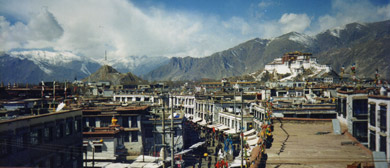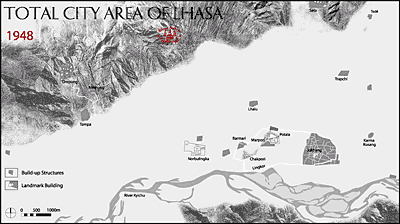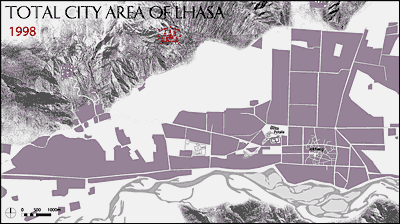A Brief Introduction of Lhasa City (written in 1998)

Setting
Fabric
Modern Time - City Development |
The Separate Character |
Demolition
Official preservation policy
A Brief Introduction of Lhasa City (written in 1998)
Setting
|
||
Modern Times |
| The Separate Character of the Old City | |
 Today's old city is an area of 1.3 square kilometers, defined by the Lingkor North, Lingkor East and Lingkor South Roads, and the Do Senge Road to the west. Despite the recent rapid redevelopment of Lhasa, the old city has kept its separate physical character. The structure here is very different, much denser than in the rest of the city. The old city has a special official status as historic area, and is designated as Lhasa's principal public housing area. Several designated food markets and bazaars are located in the central areas, and work units and government offices occupy much of the northern parts. The old city is home to 17 active Buddhist temples, two hospitals, several primary schools, a newspaper office, two cinemas, and a growing number of restaurants and tourist hotels. The city planners maintain that the old town is Lhasa's prime public housing area. One reason that they cite is the popularity of living in close proximity to the Tsuglakhang temple. Another reason is that of the land in the Lhasa valley is being developed in a partnership between privatized work units, government departments, and private property developers, while the old city is the preferred area for renting or buying apartments (proximity to the Jokhang temple, to schools and markets are cited as the main reasons for the popularity of the old area) 
To cope with the growing population development, the Planning and Construction Departments devised the policy of replacing existing old buildings with 4-storey, densely packed concrete blocks, some of which are decorated with neo-Tibetan facades. As a result of this policy, the population within the old city has approximately doubled over the last ten years. Today, it is estimated that 50.000 people (mostly ethnic Tibetans) live in the old city area, whereas the entire city population has grown to 400,000. |
| Demolition of Old Houses | |
|
|
|
Copyright, Tibet Heritage Fund
|